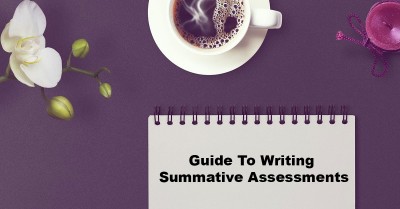When writing Summative Assessments it provides you an opportunity to summarise all the documentation you have collected on each child's learning and development and "sum" up to emphasize children's strengths and make learning visible.
How To Summarise Learning
The most efficient way to summarise learning is to use the points of evidence from the EYLF Learning Outcomes. You can include these to show what the child has achieved and by also including practical examples to show how the child has achieved each point.
For example:
Learning Outcome 1 - Children Have A strong Sense Of Identity
Hannah explore aspects of identity through role play. She enjoys dressing up during role play and acts out different roles. Hannah especially likes Doctors and collaborates with her peers on being the doctor role while her peers are the patients. She spends a considerate amount of time in Home Corner throughout the day and responds to to ideas and suggestions from her peers while engaged in and contributes to shared play experiences.
Learning Outcome 2 - Children Are Connected With And Contribute To Their World
Hannah actively seeks involvement of her peers. She is always looking for others to get involved in her play. If she sees a peer by themselves she would ask if they would to join in. Eloise is confident to express her personal opinion on matters and this is usually seen during group time discussions. She understands different ways of contributing through play and projects by gathering more materials to be including during play.
Learning Outcome 3 - Children Have A Strong Sense of Wellbeing
Hannah is connected with her friends in a happy and positive way. She shares her humor with others and is always looking at ways of making others laugh. She is also very active child and participates in physical activities such as dance and movement and uses her sensory capabilities to explore and respond to the environment. When using equipment Hannah ensures the safety of others and herself and shows independence.
Learning Outcome 4 - Children Are Confident and Involved Learners
Hannah is an enthusiastic learner. She is always one of the first to want to try something new or get involved in different projects, She is very imaginative and expresses her creativity through play and interest and contributes to play experiences emerging from her own ideas, When doing an under the sea theme, Hannah wanted to be a mermaid. She created a mermaid tail using cardboard and newspaper. She helped her friends create mermaid tails too.
Learning Outcome 5 - Children Are Effective Communicators
Hannah is confident and clear to understand when using verbal communication. She confidently engages in small and large group experiences and shows she is actively listening to and understand what is being said through the questions she asks and answers she gives, Hannah enjoys participating and contributing her ideas in group time and often sings and chants jingles and rhymes. She likes stories and uses creative art such as drawing and painting to express ideas and make meaning.
Note:
- The above examples provides points of evidence from the EYLF Outcomes.
- Includes practical examples also of how the child has achieved them.
- The practical examples could be used from the documentation you gathered such as observations, learning stories, work samples etc.
- The information provided in your Summative Assessment should be "linked" the the child's documentation. For example: the above example provides details on Hannah enjoying role play. There should be observations on Hannah that shows this.
When writing a summative assessment it should:
- emphasise children’s strengths and make their learning visible
- draw on the family’s knowledge about their child so that the documentation reflects the child’s life at home as we as at the service
- be free from bias
- be written in clear, easy-to-understand
- language that makes sense to families
- reflect knowledge of the child’s social or cultural background
- occur systematically and regularly so that, over time, educators gain a complete picture of each child’s
progress in relation to the Learning Outcomes
The following provides a full list of Points of Evidence under each EYLF Learning Outcome that can be used to summarise learning:
EYLF Outcome 1 - Child Have A Strong Sense Of Identity V2.0 - The following lists the sub outcomes, examples of evidence when children can achieve each sub outcome and how educators can promote and help children to achieve EYLF Learning Outcome 1: Children Have A Strong Sense Of Identity V2.0.
EYLF Outcome 2 - Children Are Connected With And Contribute To Their World V2.0 - The following lists the sub-outcomes, examples of evidence when children achieve each sub-outcome and how educators can promote and help children to achieve EYLF Outcome 2 - Children Are Connected With And Contribute To Their World V2.0.
EYLF Outcome 3 - Children Have A Strong Sense Of Wellbeing V2.0 - The following lists the sub-outcomes, examples of evidence when children achieve each sub-outcome and how educators can promote and help children to achieve EYLF Outcome 3 - Children Have A Strong Sense Of Wellbeing V2.0.
EYLF Outcome 4 - Children Are Confident And Involved Learners V2.0 - The following lists the sub-outcomes, examples of evidence when children achieve each sub-outcome and how educators can promote and help children to achieve EYLF Outcome 4 - Children Are Confident And Involved Learners V2.0.
EYLF Outcome 5 - Children Are Effective Communicators V2.0 - The following lists the sub-outcomes, examples of evidence when children achieve each sub-outcome and how educators can promote and help children to achieve EYLF Outcome 5 - Children Are Effective Communicators V2.0.
The following will also support you when writing Summative Assessments.
Descriptive Words For Documentation, Observations and Reports - The following is a list of descriptive words that can be used while writing.
Sentence Starters For Documentation Posters - Enable Educators to provide phrases to connect ideas more effectively when writing documentation. The following posters provide sentence starters for a range of different purposes.
Synonyms For Documentation Posters - The following posters lists synonyms that can be used when writing documentation such as observations, learning stories, reports and more. Synonyms are words or phrases that mean the same as another word. Using these posters will enable you to broaden your vocabulary when writing.
Descriptive Words For Documentation Posters - A list of descriptive words that can be used while writing. These can be used as a reference point for Educators when completing documentation.
A summative assessment builds a picture of the child progress over time, through the evidence you have collected. The Learning Outcomes provides key reference points in which a child's progress can be identified and documented and shows an overall picture of a child's learning journey.
Please note: This is based on my understanding and interpretation of Summative Assessments. There is no one way of writing them as it solely depends on the Educator writing them. The above is a simple and efficient way to write them based on my experience.







 Here is the list of the EYLF Learning Outcomes that you can use as a guide or reference for your documentation and planning. The EYLF
Here is the list of the EYLF Learning Outcomes that you can use as a guide or reference for your documentation and planning. The EYLF The EYLF is a guide which consists of Principles, Practices and 5 main Learning Outcomes along with each of their sub outcomes, based on identity,
The EYLF is a guide which consists of Principles, Practices and 5 main Learning Outcomes along with each of their sub outcomes, based on identity, This is a guide on How to Write a Learning Story. It provides information on What Is A Learning Story, Writing A Learning Story, Sample
This is a guide on How to Write a Learning Story. It provides information on What Is A Learning Story, Writing A Learning Story, Sample One of the most important types of documentation methods that educators needs to be familiar with are “observations”. Observations are crucial for all early childhood
One of the most important types of documentation methods that educators needs to be familiar with are “observations”. Observations are crucial for all early childhood To support children achieve learning outcomes from the EYLF Framework, the following list gives educators examples of how to promote children's learning in each individual
To support children achieve learning outcomes from the EYLF Framework, the following list gives educators examples of how to promote children's learning in each individual Reflective practice is learning from everyday situations and issues and concerns that arise which form part of our daily routine while working in an early
Reflective practice is learning from everyday situations and issues and concerns that arise which form part of our daily routine while working in an early Within Australia, Programming and Planning is reflected and supported by the Early Years Learning Framework. Educators within early childhood settings, use the EYLF to guide
Within Australia, Programming and Planning is reflected and supported by the Early Years Learning Framework. Educators within early childhood settings, use the EYLF to guide When observing children, it's important that we use a range of different observation methods from running records, learning stories to photographs and work samples. Using
When observing children, it's important that we use a range of different observation methods from running records, learning stories to photographs and work samples. Using This is a guide for educators on what to observe under each sub learning outcome from the EYLF Framework, when a child is engaged in
This is a guide for educators on what to observe under each sub learning outcome from the EYLF Framework, when a child is engaged in The Early Years Learning Framework describes the curriculum as “all the interactions, experiences, activities, routines and events, planned and unplanned, that occur in an environment
The Early Years Learning Framework describes the curriculum as “all the interactions, experiences, activities, routines and events, planned and unplanned, that occur in an environment


